
by Samantha Kennedy | Jul 2, 2019
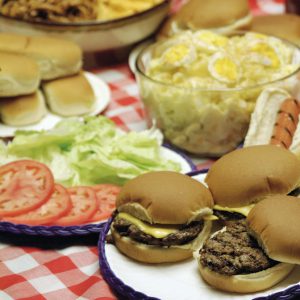
Picnics are a great way to share food and fun with friends and family. By following a few simple food safety tips, you can make sure foodborne illness doesn’t crash your party. (Photo source: UF/IFAS file photo)
There are few things more iconic during summer than a picnic. There’s just something fresh and fun about sharing a meal in the park or at the beach with family and friends. But just because you’re enjoying the warm, gentle breeze doesn’t mean you should throw caution to the wind. By following a few simple food safety tips, you can ensure that your perfectly planned picnic doesn’t make you sick.
Plan appropriately. Not all foods are picnic-appropriate. Anything that requires a lot of perishable ingredients and/or a lot of preparation should be avoided. Stick with foods that require little or no cooking and that contain just a few ingredients. Foods such as fruits and vegetables (especially whole ones), hard cheeses, peanut butter and jelly, cereal, bread, and crackers are ideal picnic items. Anything made with commercially processed custard or mayonnaise will stay safe as long as it is kept cold.
Pack it safely. Use a cooler, if possible, and store cold foods together so they can help each other stay colder longer. Use ice or frozen gel packs to help keep foods cold. Pack foods directly from the refrigerator into the cooler; don’t leave them sitting out before packing. Store ready-to-eat foods separately from raw meats. If packing up hot foods, be sure to keep them in a thermos or other insulated dish. DO NOT store them in the same container as the cold foods. Paper towels, disposable utensils, and a food thermometer are ideal picnic accessories. Remember, keep cold foods below 41 degrees F and hot foods above 135 degrees F. Do your best to keep the cooler away from direct sunlight by storing it in the shade and be sure to replenish the ice and/or frozen gel packs when they melt. If possible, store drinks in a separate cooler so cold foods are not exposed to warm air with frequent openings of the lid to retrieve drinks. This also reduces the risk of cross-contamination, with fewer hands reaching into the food cooler.
Prepare it carefully. All food items should be kept at the proper temperature at all times. When cooking raw meats, use separate plates for the raw and cooked products and clean and sanitize utensils between uses. Cook meat to the proper recommended internal temperature to ensure doneness and safety. Click here for a list of recommended internal cooking temperatures.
Clean up quickly. Discard any perishable foods that have been left out for longer than two hours. In really hot weather (generally above 90 degrees F), foods should not be left out longer than one hour. Keep food protected in storage containers such as coolers and lidded dishes to minimize contamination from flies and other pests. Serve small portions of food at a time and keep the rest in the cooler.
Picnics are an important part of summer and with just a little bit of planning and a few useful tips and tools, they can be safe and delicious for everyone!
Related links:
Food Safety at Tailgating (University of Florida/IFAS)
Picnic Safety (Iowa State University)
Checklist for the Perfect Summer Picnic (foodsafety.gov)
Extension classes are open to everyone regardless of race, creed, color, religion, age, disability, sex, sexual orientation, marital status, national origin, political opinions or affiliations.
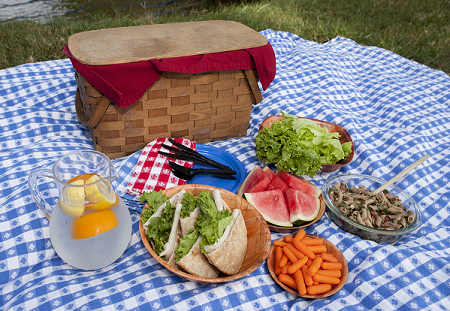
by Samantha Kennedy | Jun 27, 2017
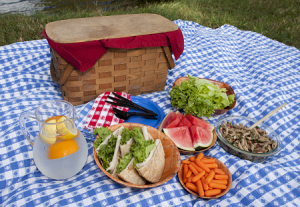 There are few things more iconic during summer than a picnic. There’s just something fresh and fun about sharing a meal in the park or at the beach with family and friends. But just because you’re enjoying the warm, gentle breeze doesn’t mean you should throw caution to the wind. By following a few simple food safety tips, you can ensure that your perfectly planned picnic doesn’t make you sick.
There are few things more iconic during summer than a picnic. There’s just something fresh and fun about sharing a meal in the park or at the beach with family and friends. But just because you’re enjoying the warm, gentle breeze doesn’t mean you should throw caution to the wind. By following a few simple food safety tips, you can ensure that your perfectly planned picnic doesn’t make you sick.
Planning it out. Not all foods are picnic-appropriate. Anything that requires a lot of perishable ingredients and/or a lot of preparation should be avoided. Stick with foods that require little or no cooking and that contain just a few ingredients. Foods such as fruits and vegetables (especially whole ones), hard cheeses, peanut butter and jelly, cereal, bread, and crackers are ideal picnic items. Anything made with commercially processed custard or mayonnaise will stay safe as long as they are kept cold.
Packing it up. Use a cooler, if possible, and store cold foods together so they can help each other stay colder longer. Use ice or frozen gel packs to help keep foods cold. Pack foods directly from the refrigerator into the cooler; don’t leave them sitting out before packing. Store ready-to-eat foods separately from raw meats. If packing up hot foods, be sure to keep them in a thermos or other insulated dish. DO NOT store them in the same container as the cold foods. Paper towels, disposable utensils, and a food thermometer are ideal picnic accessories. Remember, keep cold foods below 41 degrees F and hot foods above 135 degrees F. Do your best to keep the cooler away from direct sunlight by storing it in the shade and be sure to replenish the ice and/or frozen gel packs when they melt. Consider packing drinks in a separate cooler, as they are consumed more frequently; this will reduce the exposure of food items to warm air until you’re ready to eat.
Preparing the feast. All food items should be kept at the proper temperature at all times. When cooking raw meats, use separate plates for the raw and cooked products and clean and sanitize utensils between uses. Cook meat to the proper recommended internal temperature to ensure doneness and safety. Click here for a list of recommended internal cooking temperatures.
Presenting the bounty. Discard any perishable foods that have been left out for longer than two hours. In really hot weather (generally above 90 degrees F), foods should not be left out longer than one hour. Keep food protected in storage containers such as coolers and lidded dishes to minimize contamination from flies and other pests. Serve small portions of food at a time and keep the rest in the cooler.
Picnics are an important part of summer and with just a little bit of planning and a few useful tips and tools, they can be safe and delicious for everyone!
Source: Beaugh, Kristina. “Checklist for the Perfect Summer Picnic,” Foodsafety.gov blog, June 16, 2015. URL: https://www.foodsafety.gov/blog/2015/06/picnic.html.
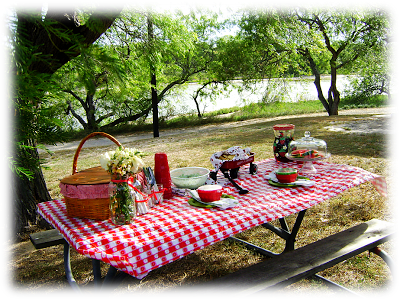
by sbouie | Jul 17, 2016
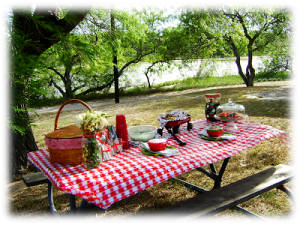 Picnics are a great opportunity for families to enjoy the great outdoors. It provides time to experience special bonding while enjoying the fresh air and delicious food. However, we should always be cautious of food borne illness.
Picnics are a great opportunity for families to enjoy the great outdoors. It provides time to experience special bonding while enjoying the fresh air and delicious food. However, we should always be cautious of food borne illness.
Let’s keep food and your family safe from the start! Whether the foods are from home, a store, or restaurant, follow the simple rules of keeping hot foods hot and cold foods cold. Remember that bacteria can grow fast at temperatures between 40°F and 140°F – the Danger Zone. Eat and promptly chill leftovers within two hours, and if the outside air temperature is above 90°F, do so within one hour.
If you plan to cook on site, make sure raw meats are packed well and are separated from ready-to-eat foods to prevent any cross-contamination. All perishable foods must be kept cold (40°F or below) in insulated boxes with enough ice, frozen gel packs, or other cold source, such as a container of frozen water. If possible, bring an appliance thermometer along to monitor the box temperature. When you grill the meat, make sure it is cooked to the right temperature. Also, bring enough potable water if none will be available at the site, and pack clean, wet, disposable cloths or moist towelettes and paper towels for cleaning hands and surfaces. Keep your tailgate party fun and bacteria-free for your family’s well-being!
Besides the food, plan your time. Plan some fun outdoor games that the entire family will enjoy. You may even plan a nature walk, name the cloud’s shape, or be creative and create your own activity. Whatever you plan, always involve the entire family. Every family member should be included.
This is the best time to say “no electronic devices.” This is time for the family to have face time without interruptions – time to talk to each other and grow closer. Picnic time translates “it’s family time” – eating outside in the fresh air and enjoying your family.
Reference: Food Safety and Tailgating, Amy Simonne. EDIS Publication #FAR8712
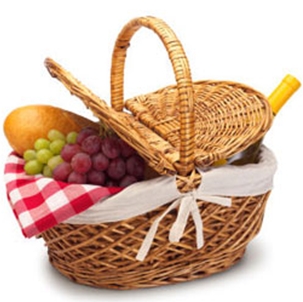
by Dorothy C. Lee | Jun 26, 2015
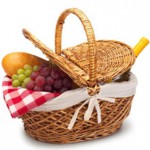 It’s that time of year…Summertime! What could be more enjoyable than a summer picnic? Along the Gulf Coast, all you need is a sunny day, white sand beach, and a menu to remember.
It’s that time of year…Summertime! What could be more enjoyable than a summer picnic? Along the Gulf Coast, all you need is a sunny day, white sand beach, and a menu to remember.
However, poor planning can turn a picnic into a small disaster, so first, check the weather forecast because a rainstorm can put a damper on your day.
Keep your food safe. Take only the amounts of food you will use. With a proper cooler and ice, most foods are safe for short periods of time. If you don’t have a cooler, some suggestions for non-perishable foods include fresh, canned, or dried fruits, raw vegetables, hard cheeses, canned or dried meats, crackers, and peanut butter.
Packing pointers: Safe packing of food is essential for picnicking safely. Starting with cold food, pack straight from the refrigerator or freezer into an insulated cooler. Package all foods in clear plastic wrap or zip-top bags. If you don’t have or want to use commercial ice packs, you can make your own by placing ice cubes in a plastic bag, then wrapping the bag in foil.
Sandwiches can be made ahead and frozen, but without veggies and condiments. Place frozen sandwiches in the cooler. They will thaw by lunchtime. Pack lettuce, tomato, and condiments in separate containers and add to sandwiches just before serving. Frozen small cans or boxes of juice, yogurt, or applesauce also will thaw by lunchtime.
Keep hot foods hot with insulated dishes or thermal containers. The rule to remember for safe foods is “Keep cold foods cold and hot foods hot.”
Once you arrive at the picnic site, don’t leave the cooler in the car or in direct sunlight – keep the cooler in the shade, keep the lid on, and avoid frequent openings. Consider using a second cooler just for drinks to reduce the exposure of food to warm air with each lid opening. Add more ice if it begins to melt. In extremely hot weather, food should not sit off refrigeration for more than one hour. Serve small portions so the food doesn’t stay out of the cooler too long.
If you plan to prepare food at the picnic site, keep food cold until you’re ready to cook it. Cook food completely at the site—no partial cooking ahead. Use a clean plate to serve cooked food. Always take care that raw meat juices don’t touch other foods.
Picnics are a great excuse to get together with family and friends. To picnic safely, plan ahead, pack foods carefully, and keep cold foods cold and hot foods hot. Then, relax and have fun!
For further information, contact:
Dorothy C. Lee, C.F.C.S.
UF IFAS Extension Escambia County
3740 Stefani Road
Cantonment, FL 32533-7792
(850) 475-5230
dclee@ufl.edu
by Amy Mullins | Jun 25, 2013
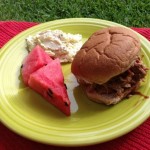
Keep hot foods hot and cold foods cold to reduce the risk of foodborne illness, especially in hot weather.
It’s time for all the fun things that summer brings, like picnics, potlucks, and outdoor gatherings. These are ways we all enjoy celebrating the summer sunshine with friends and family. As things heat up outside, don’t forget the basic rules of food safety to protect yourself and others from foodborne illness.
When transporting, preparing, and serving food outdoors, there are many critical things to consider. First, keep your hands clean. If soap and running water are not available, be prepared with disposable antibacterial wet wipes and hand sanitizer. Use it often and keep it available for everyone at your event.
Be sure to use an insulated cooler with plenty of frozen gel packs and ice for all foods that require refrigeration. Perishable foods, such as potato salads, burgers, hot dogs, chicken, and cheese, should be stored at 40 degrees or less to prevent the growth of harmful bacteria. Pack your cooler accordingly to prevent cross-contamination, securely wrapping and separating raw and ready-to-eat foods, putting raw foods on the bottom. Consider using a separate cooler for juice boxes, soda cans, and water bottles. This will help protect food items from the heat when guests are frequently opening and closing the cooler for drinks.
Cold foods should be kept in the cooler as long as possible before being taken out to serve. Once outside of the cooler, these foods should not set out any longer than 2 hours. If it is really warm (over 90 degrees), one hour should be the limit. Foods that are in the Danger Zone, which is in the range of 40-140 degrees F, for more than this length of time, will start to grow dangerous levels of bacteria. It’s a good idea to serve foods such as potato salad, cut fruit and vegetables, as well as dips and cheeses, in shallow dishes directly in contact with ice. This will help suppress the bacterial growth while it is out of the cooler.
Grilled meats and other hot foods should be kept at a minimum of 140 degrees until served. If prepared prior to the outdoor gathering, wrap foods in foil to retain heat and use a separate insulated cooler just for hot foods. These foods also should not sit out for more than one to two hours. Consider using Sterno cans to keep food hot in covered aluminum pans or chafing dishes. Always use a food thermometer to be sure meats are cooked to the proper minimum temperature (160 degrees F for burgers and 165 degrees F for chicken) before storing or serving. For additional information, check out www.fda.gov or www.foodsafety.gov.









